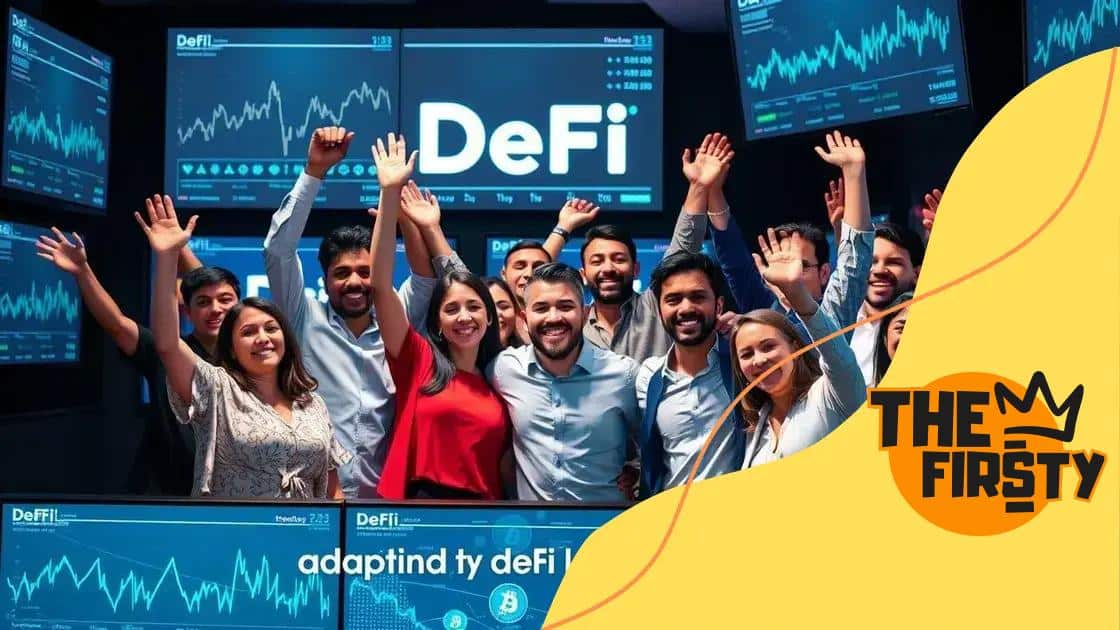Decentralized finance (DeFi) disrupting traditional banking

Anúncios
Decentralized finance (DeFi) is reshaping traditional banking by offering lower fees, enhanced transparency, and greater accessibility, allowing users to manage finances without reliance on banks.
Decentralized finance (DeFi) is changing the way we think about traditional banking. Have you ever wondered how these new financial systems operate? This article delves into the essentials of DeFi, its differences from conventional banking, and the implications for users everywhere.
Anúncios
Understanding decentralized finance (DeFi)
Understanding decentralized finance (DeFi) starts with recognizing its core principles. Unlike traditional banking systems, DeFi removes intermediaries and uses blockchain technology to enable instantaneous transactions. This shift creates financial opportunities accessible to everyone, anywhere. How does this transformation impact our everyday financial interactions?
What is decentralized finance?
Decentralized finance (DeFi) refers to a financial system built on blockchain technology. It allows individuals to lend, borrow, trade, and earn interest without the need for traditional banks. By leveraging smart contracts, DeFi platforms ensure that transactions are secure, transparent, and automated.
Key components of DeFi
Understanding the components that make up DeFi is essential:
Anúncios
- Smart contracts: Self-executing contracts with terms directly written into code.
- Decentralized applications (dApps): Software applications that run on a peer-to-peer network.
- Liquidity pools: Collections of funds locked in smart contracts that facilitate trading.
- Stablecoins: Cryptocurrencies pegged to a stable asset to reduce volatility.
How does DeFi work?
DeFi platforms operate through various protocols that enable users to engage with financial services without intermediaries. Users connect their cryptocurrency wallets to these platforms, allowing them to interact with different financial products. For example, a user can deposit their cryptocurrency into a lending platform and earn interest, while another user may borrow against their assets.
This system empowers users by providing greater control over their finances, lower fees, and a wider range of financial services. Additionally, DeFi fosters innovation in financial technologies, leading to the development of new tools and offerings that cater to a diverse audience.
Furthermore, the global nature of DeFi means that financial services are available to anyone with internet access, breaking down geographic and economic barriers. This democratization of finance ensures that individuals in underserved regions can participate in the global economy.
How DeFi differs from traditional banking
How DeFi differs from traditional banking is an essential topic for understanding the financial landscape today. While traditional banks have dominated finance for centuries, decentralized finance (DeFi) offers a novel approach that challenges many conventional practices.
Centralization vs. decentralization
Traditional banking is centralized, meaning a few institutions control the flow of money. This centralization can lead to issues like slow transactions and higher fees. In contrast, DeFi operates on blockchain technology, promoting a decentralized model that allows users to transact directly with one another. This shift not only reduces intermediaries but also increases efficiency.
Accessibility and inclusivity
With traditional banking, access can be limited. Many people worldwide do not have bank accounts due to high fees or geographic constraints. DeFi seeks to break down these barriers by providing financial services to anyone with an internet connection. This system fosters inclusivity and offers opportunities for underbanked populations.
- No minimum balances: Unlike most banks, DeFi platforms do not require users to maintain a minimum balance.
- 24/7 availability: DeFi services are accessible at any time, unlike traditional banks that operate on set hours.
- Lower fees: DeFi often has lower transaction costs, making it more economical for users.
- Global access: Users from anywhere can access DeFi platforms, expanding financial possibilities.
Moreover, traditional banks are often subject to regulations that may limit their flexibility. In contrast, DeFi promotes innovation by enabling developers to create new financial services without needing to navigate complex regulations. This freedom fuels creativity and solutions that cater to diverse user needs.
While traditional banking relies on trust in institutions, Defi instills trust in technology. Transactions are verified through blockchain’s transparency. This level of trust shifts how people view financial interactions, as users can independently verify the integrity of each transaction without relying on third parties.
Key benefits of adopting DeFi solutions

Key benefits of adopting DeFi solutions are transforming the way people interact with finance. As traditional banking systems face various limitations, many users are turning to decentralized finance (DeFi) for its numerous advantages.
Enhanced security
One major benefit of DeFi is the enhanced security it offers. With blockchain technology, transactions are encrypted and recorded on a public ledger, making fraud much harder to achieve. Users have greater control over their funds, reducing the risks associated with centralized banking.
Lower costs
DeFi typically has lower fees than traditional banking services. Without intermediaries, costs associated with transactions and services are minimized. This means that users get more value for their money, whether they are lending, borrowing, or trading.
- No hidden fees: Many DeFi platforms are transparent about their costs.
- Reduced transaction fees: Transactions are often cheaper and faster with DeFi.
- Incentives for participation: Users can earn rewards by participating in DeFi activities.
- Global access: Lower costs enable people worldwide to access financial solutions.
The flexibility of DeFi allows users to tailor financial products to their specific needs. Traditional banks often have rigid services, but DeFi platforms offer innovative solutions that adapt to changing market demands.
Additionally, users enjoy increased financial freedom. With DeFi, there is no need for permission from third parties to complete transactions. This independence empowers users to manage their assets and make financial decisions without excessive oversight.
Instant transactions are another vital advantage. DeFi platforms facilitate real-time trading and transfers, expediting processes that can take days in traditional banking systems. This immediacy can significantly impact trading strategies and financial planning.
Challenges facing DeFi adoption
Challenges facing DeFi adoption are significant as more people explore decentralized finance. Despite its many advantages, several obstacles hinder widespread acceptance and use of DeFi solutions.
Regulatory uncertainty
One of the primary challenges is the lack of clear regulations. Governments around the world are still grappling with how to classify and regulate DeFi. This uncertainty can create hesitance among users and investors, as they may fear sudden regulatory changes that could impact their investments.
Complexity and usability
The technical complexity of DeFi platforms can discourage new users. Many people find it challenging to navigate wallets, smart contracts, and various protocols. This complexity may prevent potential users from fully embracing the technology and its benefits.
- Learning curve: Users must invest time to understand how to use DeFi platforms effectively.
- User interface issues: Some platforms have complicated interfaces that make them less appealing.
- Security risks: Users might be concerned about scams and hacks due to the rapid development of DeFi.
- Integration difficulties: Users often struggle to integrate DeFi with existing financial systems.
Additionally, while blockchain technology offers security, it is not entirely immune to risks. Users face potential threats such as hacks and exploits, especially on lesser-known platforms. This could compromise their assets and create distrust in the systems.
Moreover, liquidity challenges can arise in DeFi. Many platforms require a certain amount of funds to function effectively. If there isn’t enough liquidity, it can lead to high slippage and unfavorable trading conditions. This situation makes it challenging for users to execute trades without losing money.
Lastly, the steep competition among DeFi platforms creates challenges. Numerous projects emerge daily, making it difficult for users to decide which ones to trust and invest in. This abundance can overwhelm potential users, preventing them from choosing a platform that suits their needs.
The future of banking in a DeFi world
The future of banking in a DeFi world looks promising as decentralized finance continues to grow. This evolution challenges traditional banking systems and presents new opportunities for individuals and businesses alike.
Transformation of financial services
The landscape of financial services is shifting dramatically. With DeFi, consumers can access a wide range of financial products without relying on banks. This includes lending, borrowing, trading, and earning interest on assets.
Increased transparency
One major advantage of DeFi is its transparency. Every transaction is recorded on the blockchain, allowing users to verify and track their activities in real time. This level of transparency enhances trust among users, making financial transactions straightforward and accountable.
- Real-time data: Users can access up-to-date information about their finances.
- Open-source protocols: Many DeFi projects are open for anyone to see and use.
- Community governance: Users can participate in decision-making processes regarding the platforms they use.
As decentralized technologies advance, traditional banks may need to adapt. This might involve integrating DeFi features into their offerings, such as blockchain-based payment systems or smart contracts to automate processes.
Moreover, the rise of DeFi could lead to a more inclusive financial environment. People currently unbanked may gain access to financial services through digital platforms. As a result, economic opportunities can expand, fueling growth in different regions of the world.
In addition, competition from DeFi can drive banks to lower fees and offer innovative products to retain their customers. This positive competition benefits consumers by providing more choices and better services.
As we look ahead, the combination of DeFi and traditional banking may create hybrid systems that leverage the strengths of both. This evolution can enhance user experiences while maintaining regulatory compliance and security.
FAQ – Frequently Asked Questions about the Future of Banking in a DeFi World
What is DeFi?
DeFi, or decentralized finance, refers to financial systems that operate without traditional banks by using blockchain technology.
How does DeFi enhance financial accessibility?
DeFi allows anyone with internet access to use financial services, making banking available to unbanked populations.
What benefits does DeFi offer over traditional banking?
DeFi offers lower fees, increased transparency, and faster transactions compared to traditional banking systems.
Will traditional banks adopt DeFi practices?
Yes, many traditional banks may begin to incorporate DeFi solutions to stay competitive and meet customer demands.





